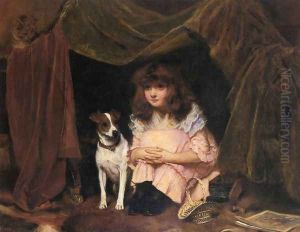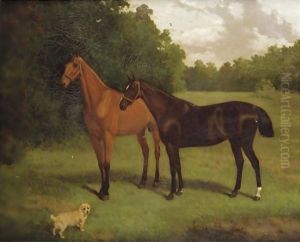Charles (Burton) Barber Paintings
Charles Burton Barber was an English painter who became famous for his depictions of children and their pets. Born on September 4, 1845, in Great Yarmouth, Norfolk, Barber showed an early interest in art and was enrolled at the Royal Academy Schools in London by the age of 18. He was a diligent student and soon began to gain recognition for his works. Barber's genre was primarily Victorian-era narrative art, and he became particularly known for his skillful representation of dogs, which earned him a reputation as one of the foremost animal painters of his time.
Throughout his career, Barber was a favorite of Queen Victoria, who commissioned him to create several paintings for her, including depictions of her grandchildren with their pets. His ability to capture the innocence of childhood and the loyalty of pets resonated with the Victorian public. His paintings often portrayed an idealized version of childhood and were characterized by their sentimental, yet highly detailed, realism.
Barber's works were widely exhibited during his lifetime, including at the Royal Academy of Arts. His paintings were also engraved, which helped to increase his popularity and the dissemination of his works among the middle classes of Victorian society. Some of his most notable paintings include 'A Special Pleader', 'Blonde and Brunette', and 'The Broken String'. Barber's focus on domestic scenes and the bond between children and their pets provided a comforting and nostalgic counterpoint to the rapid industrialization and social changes occurring in Britain at the time.
Unfortunately, Barber's life was relatively short; he died on December 18, 1894, in London. Despite his early death, his work left a lasting impact on Victorian art, and his paintings are still appreciated today for their charm and technical skill. Barber's works can be found in various art galleries and private collections around the world, continuing to enchant viewers with their portrayal of the special relationships between humans and animals.

